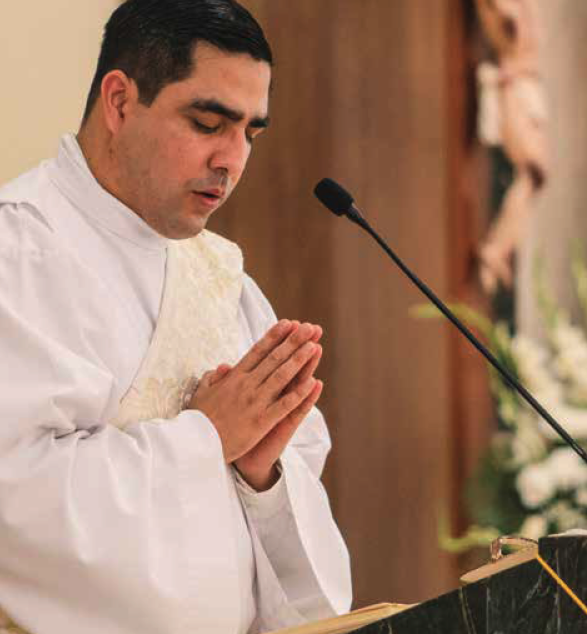Identifying Homiletic Resources
Exploring intellectual content for homilists
Kevin Aldrich Comments Off on Identifying Homiletic Resources
A serious problem the Church faces today is the laity’s lack of faith formation. This decades-old deficit has become grave. The laity’s poor formation stands in the way of remaining faithful to God in an increasingly hostile culture. It certainly prohibits re-evangelization of that culture.
Back in 2011, in Porta Fidei, the apostolic letter announcing the Year of Faith (2012-13), Pope Benedict XVI directed us to “rediscover the content of the faith that is professed, celebrated, lived and prayed, and to reflect on the act of faith” (No. 9). Pope Benedict was underlining the truth that our Catholic faith has an intellectual content to be known; it can be embraced in faith, pondered in prayer, lived in practice and taught to others open to it.
More recently, Pope Francis highlighted “the co-responsibility of the laity in the building up of the Church,” quoting Pope St. John Paul II’s 1988 apostolic exhortation Christifideles Laici. How can members of the laity give valid advice to the hierarchy and collaborate in its work if they don’t know and live the Faith themselves? Or how can the laity live their lay vocations to engage with the secular world if they don’t know and live the Faith? A question for the homilist is, How can the laity be helped to live their lay vocations?
I believe the answer is a doctrinal and practical formation. Doctrinal formation means that the laity grasp the central doctrines of the Faith to the depth they are capable. For example, does a father whose child is preparing for first Communion know that the Eucharist is the real presence of Christ under the sacramental species? Practical formation means knowing how to live the Faith in whatever culture we find ourselves in and actually living it. For example, does this father himself observe the Sunday obligation to attend Mass, practice the required fast and display reverence toward the Sacrament, including dressing well, genuflecting toward the tabernacle when entering and leaving the church, and not chewing gum during Mass?
Two further questions about doctrinal and practical formation are when and how. While there are many ways faith formation ought to be given, I am convinced that the homily is the best opportunity pastors have to help the laity deepen their knowledge and practice of the Faith. The reason: The Sunday Mass is the one time each week when all the faithful who practice their faith are present. When else can homilists address the faithful who are at least minimally faithful?
Systematic Catechesis
I have a remarkable pamphlet published in 1941 by my diocese’s former bishop for his priests. It included a directory for sermons for the coming year. The focus for the year was human and supernatural virtues. During the course of the liturgical year, the laity was to hear expositions not just on the supernatural virtues of faith, hope and love, but also on prudence, justice, temperance, fortitude and a host of related human virtues. That was a systematic catechesis!
That particular bishop’s approach harkened back to what Sts. Barnabas and Paul did at Antioch in the first century. As St. Luke records, “For a whole year they met with the church and taught a large number of people, and it was in Antioch that the disciples were first called Christians” (Acts 11:26). In a sense, the laity become Christians by learning and living the Faith.
Today, however, the homily might not seem the natural place for doctrinal catechesis. The General Instruction of the Roman Missal tells us the homily “should be an explanation of some aspect of the readings from Sacred Scripture or of another text from the Ordinary or the Proper of the Mass of the day and should take into account both the mystery being celebrated and the particular needs of the listeners” (No. 65).
The Day’s Reading as Basis
In other words, the Magisterium is telling us the homily should be drawn from the Mass texts, especially the Lectionary readings.
So, a problem for catechesis in the homily is that while the Lectionary for Mass is a rich presentation of the sacred Scriptures following a systematic plan, the Scriptures are not, of course, a systematic presentation of the Faith. Nevertheless, the doctrines of the Faith are contained in Scripture, so the Lectionary readings can be the basis for preaching about doctrine. Certainly, one of the critical “particular needs of the listeners” is a sound doctrinal catechesis. Hence, Benedict gave us the Year of Faith.
How can the Lectionary readings be the basis for teaching doctrine and living it? Here is one example. In this Year B for the Fourth Sunday in Ordinary Time, the second reading, an excerpt from St. Paul’s First Letter to the Corinthians (1 Cor 7:32-35), provides an opportunity to speak about the nature of marriage, the vocation to marriage and how to defend our understanding of it to others. The reading can also be a springboard to discuss the relationship between chastity, celibacy and marriage. Looked at this way, the homilist’s problem switches from “What shall I speak about?” to “How can I best limit what I could say?”
Sufficient Opportunities
My experience is that the three-year cycle of Lectionary readings provides sufficient opportunities to cover all the fundamental aspects of faith, morals, virtues and practice. One practical resource the Homiletic Directory provides is themes suggested that relate to the readings. These are keyed into points from the Catechism of the Catholic Church.
For example, for this same Fourth Sunday in Ordinary Time, the directory presents the following possible homily themes:
Catechism 547-550: Jesus accompanies words with miracles
Catechism 447, 438, 550: Jesus’ power over demons
Catechism 64, 762, 2595: the role of the prophet
Catechism 922, 1618-1620: virginity for the sake of the Kingdom
During the Year of Faith, I began to offer a free, internet-based service to priests and deacons to make their homilies more doctrinally rich and practically applicable to the lives of lay people. This website is called Doctrinal Homily Outlines. Each week provided an abundance of points based on the Lectionary readings under the headings of central idea, doctrine and practical application. Since then, I continued this apostolate each year, working through the cycle of readings two times. When the Homiletic Directory was published in 2015, I began to incorporate some of the themes the Congregation for Divine Worship and the Discipline of the Sacraments suggested. Unfortunately, this past September, this website was hacked and virtually destroyed, and so more than 10-years-worth of homily outlines have been lost. I don’t know if the website can be repaired or rebuilt, but I think the method can still yield a lot of good for homilists.

According to the model I have developed, I believe each homily can:
— Articulate a central salvific theme contained in the Lectionary readings for the day.
— Identify, define, explain and illustrate a doctrine from the Deposit of Faith or Catholic morals that the readings suggest.
— Offer some practical ways the laity can apply this knowledge to their lives in order to actually live the Faith.
How to apply all this to an actual set of Lectionary readings? In my own literary analysis of the same readings for the Fourth Sunday in Ordinary Time, Year B (coming up on Jan. 29), I called the central idea I discovered, “Authentic prophets who teach with authority.”
The first reading has to do with Moses’ prophecy that God will send more prophets to Israel and also an ultimate prophet, whom we know to be Jesus Christ; the responsorial psalm is about not hardening our hearts to God’s message; and the Gospel shows Jesus speaking with authority.
For a doctrine of the Faith, I focused on the second reading in which Paul spoke to the Corinthians about marriage, so I explicated key points about the Christian vocation to marriage from the Catechism. Then, for a practical application, I made suggestions about how lay people can both understand and defend marriage, obviously something critically important today.
But where to find time to ponder each reading, to find a common theme, to discover some doctrine of faith or morals, and to offer practical suggestions? I think there is no better time or place than during a half-hour of mental prayer each morning with the readings and the Catechism, and a pencil and paper.
In this way, the homilist will have far more than enough for a 5-to-15-minute homily. The homilist will be able to nourish the faithful by explaining the Word of God to them, to answer the call of Pope Benedict to teach doctrine, and, finally, to fulfill an urgent particular need of the laity: How practically to apply the Faith in our ordinary lives.
No homily can fully expound all the riches contained in any set of Lectionary readings, but every homily can explain some of them. Homilists can help to draw out the doctrinal riches, which the Scriptures contain. In addition, homilists can connect these doctrines to the ordinary lives of the laity. Each week, the homilist can offer the faithful a new facet of the intellectual content of our faith so the faithful can embrace it, ponder it, live it and even teach it to others as part of the New Evangelization.
KEVIN ALDRICH teaches English and theology at a Catholic high school, holds master of art degrees in each discipline, and has contributed to curriculum development.
…………………………………………………………………………………………………………………………………………………..
The Importance of the Homily
In Pope Benedict XVI’s apostolic exhortation Verbum Domini we read: “The homily is a means of bringing the scriptural message to life in a way that helps the faithful to realize that God’s word is present and at work in their everyday lives. It should lead to an understanding of the mystery being celebrated, serve as a summons to mission, and prepare the assembly for the profession of faith, the universal prayer and the Eucharistic liturgy. Consequently, those who have been charged with preaching by virtue of a specific ministry ought to take this task to heart. Generic and abstract homilies which obscure the directness of God’s word should be avoided, as well as useless digressions which risk drawing greater attention to the preacher than to the heart of the Gospel message. The faithful should be able to perceive clearly that the preacher has a compelling desire to present Christ, who must stand at the center of every homily. For this reason preachers need to be in close and constant contact with the sacred text; they should prepare for the homily by meditation and prayer, so as to preach with conviction and passion” (No. 59).
……………………………………………………………………………………………………………………………………………………..





